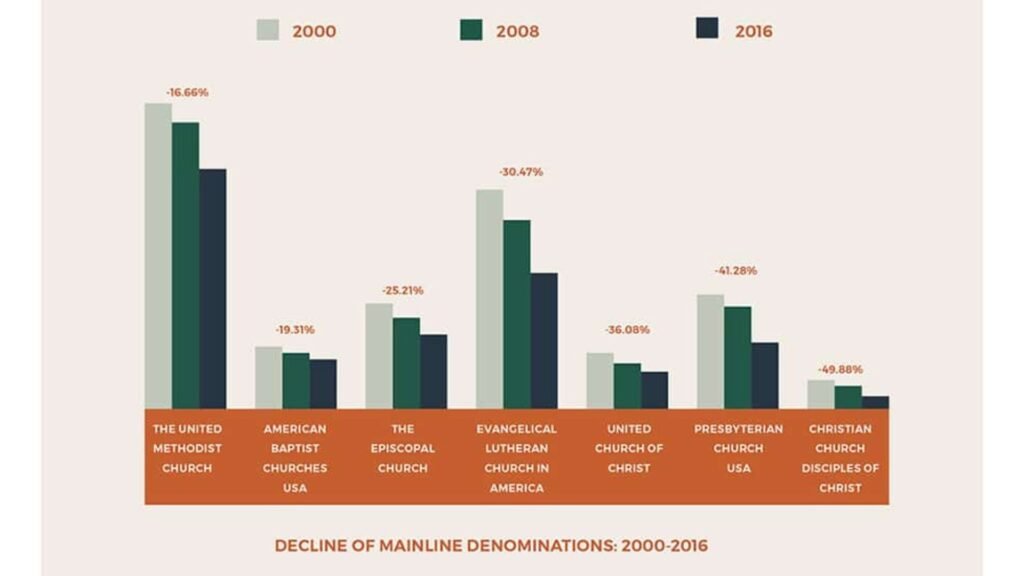Non-denominational churches have seen significant growth in recent years, reflecting shifts in worship preferences and community engagement. This growth is influenced by various factors, including evolving worship practices, increased emphasis on personal faith, and broader community outreach. Here’s a look at the key growth trends in non-denominational churches.

Increasing Numbers and Expanding Reach
1. Growing Congregations: Non-denominational churches are experiencing a rise in membership across various regions. This trend is evident in both urban and rural areas, as more individuals seek out flexible and modern worship environments that align with their personal faith journeys.
2. New Church Plants: There has been a notable increase in the number of new non-denominational churches being established. These new church plants often emerge in areas with growing populations or underserved communities, reflecting a strategic effort to reach more people with contemporary and adaptable worship experiences.
Evolving Worship Practices
1. Contemporary Worship Styles: Non-denominational churches continue to lead in offering contemporary worship styles. This includes modern music, casual settings, and innovative approaches to worship that resonate with a diverse range of individuals. The focus on engaging and relevant worship practices attracts those looking for a dynamic church experience.
2. Digital Engagement: The rise of digital technology has influenced worship practices in non-denominational churches. Many churches now offer online services, live streaming, and digital resources to reach individuals who may not be able to attend in person. This digital engagement helps expand their reach and adapt to changing communication preferences.
Emphasis on Personal Faith and Growth
1. Personalized Spiritual Development: Non-denominational churches place a strong emphasis on personal spiritual growth. This focus on individualized faith journeys allows members to explore their spirituality in a way that is meaningful to them, leading to a more engaged and committed congregation.
2. Practical Teaching: Sermons and teachings in non-denominational churches often address practical aspects of daily life, helping individuals apply Biblical principles to their personal and professional experiences. This approach appeals to those seeking actionable insights and relevance in their faith practice.
Expanding Community Outreach
1. Increased Service Projects: Non-denominational churches are expanding their community outreach efforts. Many churches engage in various service projects, including volunteering at local shelters, organizing community events, and supporting charitable initiatives. This increased focus on community involvement helps address local needs and build stronger connections with the broader community.
2. Global Missions: Alongside local outreach, non-denominational churches are also investing in global missions. These churches often support international projects and partnerships, reflecting a commitment to making a positive impact beyond their immediate communities.
Diverse Congregations and Inclusive Atmosphere
1. Broadening Appeal: The inclusive and welcoming atmosphere of non-denominational churches attracts a diverse congregation. People from various backgrounds and experiences find a sense of belonging and acceptance in these churches, contributing to their growing membership.
2. Multigenerational Communities: Non-denominational churches often foster multigenerational communities where individuals of different ages and life stages can connect and support each other. This diversity enhances the church’s dynamic and broadens its appeal.
Innovative Leadership and Organizational Models
1. Collaborative Leadership: Non-denominational churches frequently adopt collaborative leadership models. This approach often involves a team of pastors or leaders working together, which can lead to innovative and flexible church operations. The collaborative model helps address the diverse needs of the congregation and adapt to changing circumstances.
2. Flexible Organizational Structures: The absence of a formal denominational hierarchy allows non-denominational churches to implement flexible organizational structures. This flexibility supports creative problem-solving and allows churches to respond effectively to the needs of their communities.
Embracing New Technologies
1. Social Media and Online Presence: Non-denominational churches are increasingly utilizing social media platforms to engage with their congregations and reach potential members. Active social media presence helps churches stay connected with their community, share updates, and foster online engagement.
2. Mobile Apps and Digital Tools: Many non-denominational churches are adopting mobile apps and digital tools to enhance the worship experience. These tools offer features such as event registrations, sermon podcasts, and prayer requests, making it easier for members to stay involved and connected.
Conclusion
The growth trends in non-denominational churches reflect a dynamic and evolving landscape. With increasing numbers, expanding reach, and innovative worship practices, these churches are attracting a diverse and engaged congregation. Their emphasis on personal faith growth, community outreach, and digital engagement demonstrates a commitment to meeting the needs of today’s believers. By embracing contemporary practices and fostering inclusive environments, non-denominational churches continue to make a significant impact in their communities and beyond.











